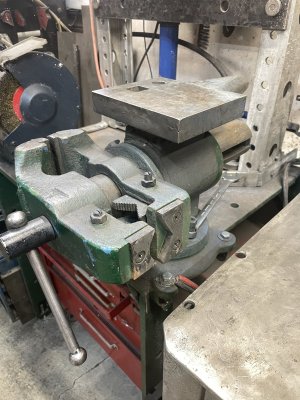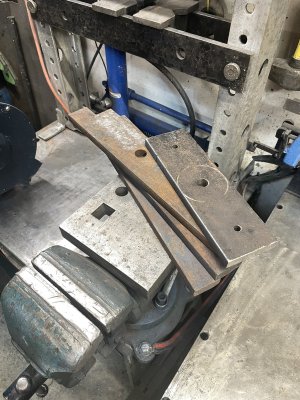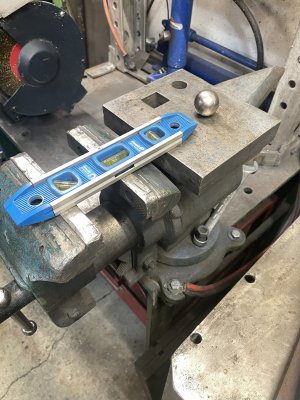-
Scam Alert. Members are reminded to NOT send money to buy anything. Don't buy things remote and have it shipped - go get it yourself, pay in person, and take your equipment with you. Scammers have burned people on this forum. Urgency, secrecy, excuses, selling for friend, newish members, FUD, are RED FLAGS. A video conference call is not adequate assurance. Face to face interactions are required. Please report suspicions to the forum admins. Stay Safe - anyone can get scammed.
-
Several Regions have held meetups already, but others are being planned or are evaluating the interest. The Calgary Area Meetup is set for Saturday July 12th at 10am. The signup thread is here! Arbutus has also explored interest in a Fraser Valley meetup but it seems members either missed his thread or had other plans. Let him know if you are interested in a meetup later in the year by posting here! Slowpoke is trying to pull together an Ottawa area meetup later this summer. No date has been selected yet, so let him know if you are interested here! We are not aware of any other meetups being planned this year. If you are interested in doing something in your area, let everyone know and make it happen! Meetups are a great way to make new machining friends and get hands on help in your area. Don’t be shy, sign up and come, or plan your own meetup!
You are using an out of date browser. It may not display this or other websites correctly.
You should upgrade or use an alternative browser.
You should upgrade or use an alternative browser.
NEED ANVIL?
- Thread starter KeeponDragon
- Start date
Tom Kitta
Ultra Member
Can you still face it if the anvil is cast though?
A guy would need a helluva heat source to warm it up enough no?
These are cast steel - does not seem to need to be faced and does not chip easily.
Cast iron on the other hand may need to be fixed by adding say hardened plate to the top. Using hardened electrodes may help but you would need a lot of these - I did repair work and if you are not paying low auction prices it does not make any financial sense.
Former Member
Guest
These are special rods specifically for hardening metal, there is a YouTube video on this. If I remember correctly you grind the face at the end to the finish. This works to save old worn Anvils or new not so good one to bring them up to an acceptable level.
Can you still face it if the anvil is cast though?
A guy would need a helluva heat source to warm it up enough no?
Most anvils that you find nowadays are going to be cast steel anvils. I would be surprised to find a modern anvil these days with a cast iron body with a high carbon face plate.
Tom Kitta
Ultra Member
Most anvils that you find nowadays are going to be cast steel anvils. I would be surprised to find a modern anvil these days with a cast iron body with a high carbon face plate.
The very cheapest anvils you could get some time ago were cast iron without any plate. There are many videos online which called them "anvil like objects".
Face plates were not added to these - just cast iron or whatever scrap was available.
One could "rescue" such anvil - if one were to care - by welding to the top a plate of say hardened 4000 series steel.
Recently situation changed - we now don't see too many new cast iron anvils but only cast steel - and this cast steel category is quite usable as many members have pointed out.
Mine is cast steel.The very cheapest anvils you could get some time ago were cast iron without any plate. There are many videos online which called them "anvil like objects".
Face plates were not added to these - just cast iron or whatever scrap was available.
One could "rescue" such anvil - if one were to care - by welding to the top a plate of say hardened 4000 series steel.
Recently situation changed - we now don't see too many new cast iron anvils but only cast steel - and this cast steel category is quite usable as many members have pointed out.
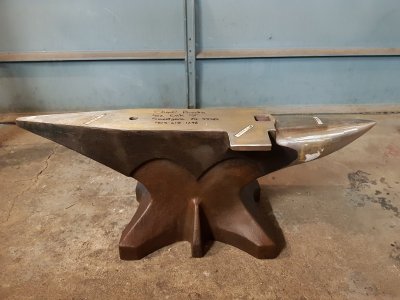
I tried to get one of these but they were already sold out. Beautiful piece.Mine is cast steel.
View attachment 41588
Former Member
Guest
My understand on cheap anvils you can hardface the surface with a particular stick welding rod. A couple of passes and a grind gets you there. There is a YouTube video on this method.
That anvil is a work of art. I think you said it is 5160?
I believe that it is cast from SAE 8160.
So if you use a hard surfacing/etc. rod on cast iron anvil, there will be a boundary layer of hard, tough, material. It can be ground as needed, or sometimes machined. This welded material/ rod would have to be compatable with the cast iron, is another type of weld put over that?
I am wondering how well the first boundary layer stands up to pounding an anvil receives in use?
I am wondering how well the first boundary layer stands up to pounding an anvil receives in use?
Tom Kitta
Ultra Member
So if you use a hard surfacing/etc. rod on cast iron anvil, there will be a boundary layer of hard, tough, material. It can be ground as needed, or sometimes machined. This welded material/ rod would have to be compatable with the cast iron, is another type of weld put over that?
I am wondering how well the first boundary layer stands up to pounding an anvil receives in use?
You use cast steel electrode on top of which you place hard metal electrode - which can be something like 12000 series electrode as well.
Actual costs of doing this are significantly higher then the purchase price of the cheap anvil. You can only do this if you get rod cheap at auction. Also takes like forever to do.
Source - I did it with one anvil. I only rebuild broken off sides. Still tons of work.
Welding hardened steel top plate is like 100x faster and easier. I assume much cheaper as well.
For most cast welding you should for best results pre-heat the cast iron. I welded cast many times.
I think folks are also seriously underestimating the quality of modern cast steel anvils. These are *not* the crappy cast things Harbor Freight used to sell.Actual costs of doing this are significantly higher then the purchase price of the cheap anvil. You can only do this if you get rod cheap at auction. Also takes like forever to do.
Reputable, modern cast steel anvils are properly hard and quite affordable.
Tom Kitta
Ultra Member
I think folks are also seriously underestimating the quality of modern cast steel anvils. These are *not* the crappy cast things Harbor Freight used to sell.
Reputable, modern cast steel anvils are properly hard and quite affordable.
The hard facing was referring to refurbishing "cast iron" anvil. "cast steel" is a different kind of animal.
Yes, I make the same mistake interchanging cast iron and cast steel even in my post. But there is a difference. Cast iron anvils used to be sold and used to be crap (and still are if you find them). Cast steel anvils are much better, now widely sold and even cheap stuff from PA is light years ahead of what we used to have from PA - i.e. cast iron.
"Cast iron typically contains more than 2 percent carbon, while cast steel often contains between 0.1–0.5 percent carbon."
Cast iron is both cheaper material and cheaper to cast... so it was used for anvil shaped objects...
Cast steel can also have many grades - I bet stuff from PA is not some high end ally being cast.
Sorry for the late entry to this thread - I’d missed it.
(The purpose of the anvil project, from before covid, was to try out a new plasma cutter.)
I don’t often need an anvil so my small home made version is good enough and doesn’t suck up a lot of space.
Originally the top of the vise had a 3 x4” flat section (blue arrows, pic below). Welded onto the flat section is stacked 5/8 x 3” flat bar. The vise can easily be rotated 180 degrees by using the 3/4” nuts that are welded to the swivel locks (the 3/4” wrench resides there).
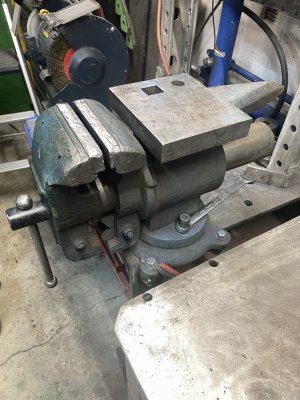
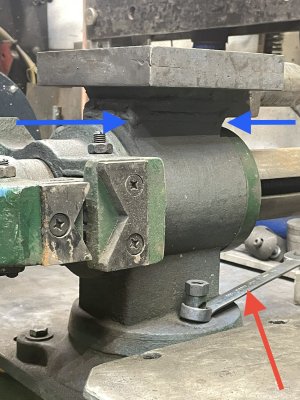
Plasma cut marks can be seen on the horn:

The thickness was adjusted so that it is level with the top of the vise jaws (3 pieces of the 5/8” bar + a spacer). Dropping a steel ball from 12” gets about a 2 1/2” rebound, a bit disappointing but ok. The vise is grounded to the adjacent fab table.
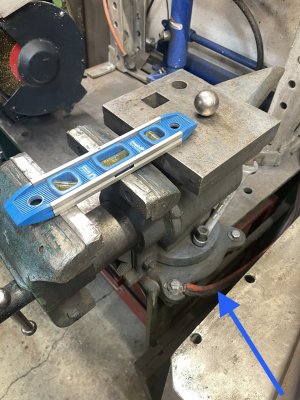
(The purpose of the anvil project, from before covid, was to try out a new plasma cutter.)
I don’t often need an anvil so my small home made version is good enough and doesn’t suck up a lot of space.
Originally the top of the vise had a 3 x4” flat section (blue arrows, pic below). Welded onto the flat section is stacked 5/8 x 3” flat bar. The vise can easily be rotated 180 degrees by using the 3/4” nuts that are welded to the swivel locks (the 3/4” wrench resides there).


Plasma cut marks can be seen on the horn:

The thickness was adjusted so that it is level with the top of the vise jaws (3 pieces of the 5/8” bar + a spacer). Dropping a steel ball from 12” gets about a 2 1/2” rebound, a bit disappointing but ok. The vise is grounded to the adjacent fab table.


